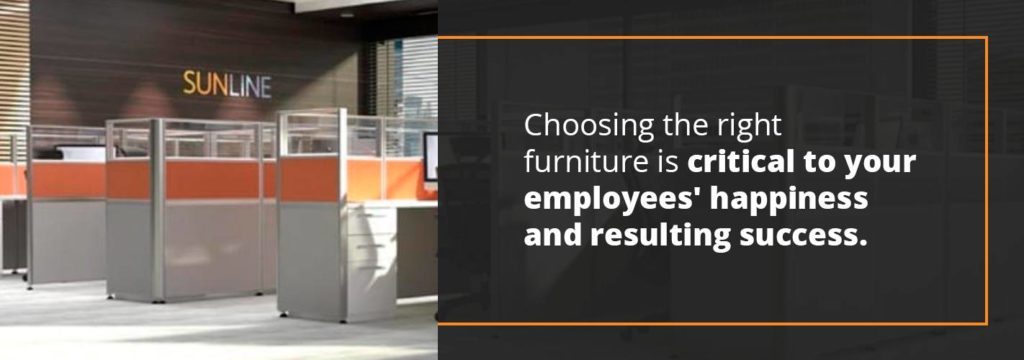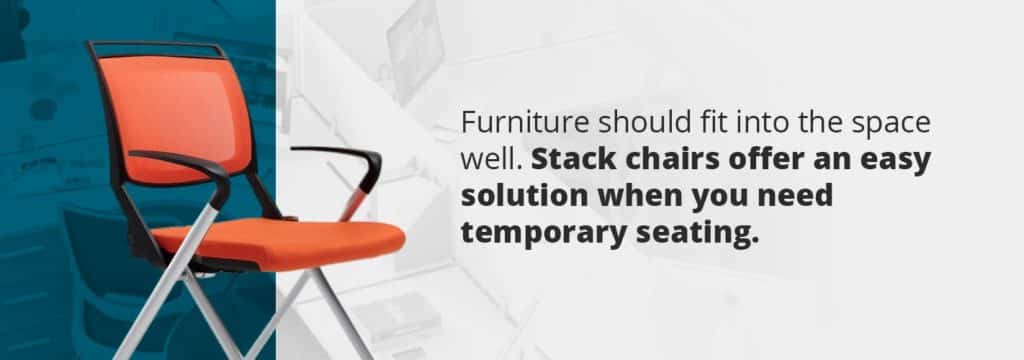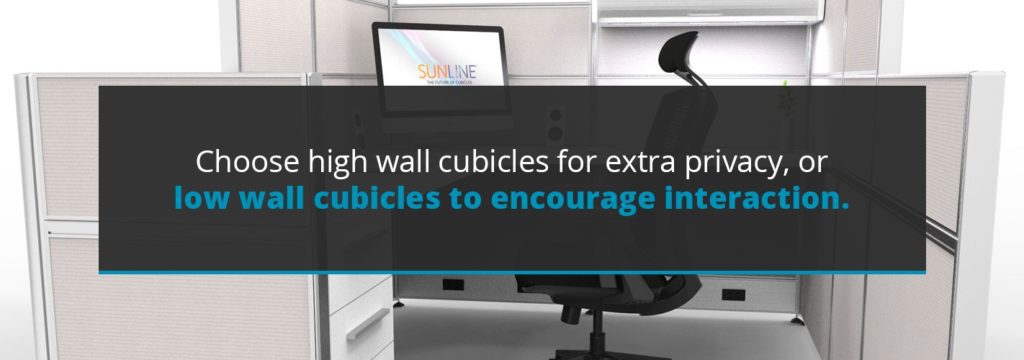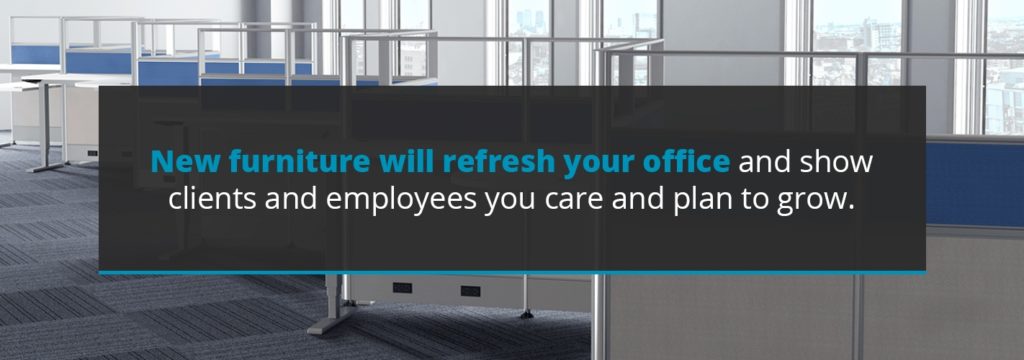Table of Contents
- Office Design Guide
- Chapter 2: What Are the Common Types of Office layouts?
- Chapter 3: How to Choose an Effective Office Layout for Your Company
- Chapter 4: Office Design Ideas and Considerations
- Chapter 5: How to Choose the Right Office Furniture
- Chapter 6: How to Install and Assemble Office Furniture

Think of a time you sat in a really uncomfortable chair. If you can recall, it was probably hard to focus on anything other than your discomfort. Now, imagine employees sitting in uncomfortable chairs all day. It’s probably not a pretty image regarding productivity.
Choosing the right furniture is critical to your employees’ ability to create their best work. When you choose office furniture, you invest in your employees’ health and the future of your company. So, when it comes to office design, it’d be better to splurge on new desk chairs than a climbing wall — if your budget requires you to choose.
You’ll encounter many options when it’s time to shop for office furniture, and it might feel overwhelming at first. Let this chapter be your office furniture buying guide. We’ll explore your options and provide some helpful tips. If you need help along the way, reach out to us at Sunline Office.
How To Get Started
Buying new office furniture requires careful consideration, and you don’t want to run through the process too fast. Before you invest in any new pieces, take these steps:
- Examine your space: First, consider the rooms you need to furnish. Do you need to buy furniture for a new conference room, or are you planning to add new pieces to all the workspaces? Evaluate the furniture’s current condition in every room, and think about how you’ll create a cohesive look throughout the entire office. Also, consider the layouts you want to create and how new furniture can make that happen.
- Assess your needs: Think about the purpose of each room and the number of employees you need to accommodate. For example, how many employees will be able to use the new communal space at once? Or, if you want to encourage employees to stand more often, how many standing desks will you need?
- Think about aesthetics: What look are you going for with your office makeover? Are you trying to create an outdoorsy, productivity-boosting style, or a playful, colorful look to spur innovation? Think about color schemes and your design style and what you want to accomplish overall. Aim to choose furniture pieces that increase the visual appeal of the whole office.
- Review your budget: As mentioned in the previous chapter, you’ll need to know how much you can spend on furniture before you shop. Be sure to prioritize pieces that will improve your employees’ comfort and health, such as ergonomically designed desk chairs or private cubicles. If there’s room in your budget after choosing must-have pieces, consider ways to enhance bonus spaces, like outdoor areas.
- Make a list: If you have a lot of rooms to furnish, it’ll help to make a list. Create a list of all the furniture you need so that you don’t forget anything.
What Should I Look For In Office Furniture?
When you’re ready to shop for office furniture, make sure to look for the following qualities:

- Durable: Choose furniture that’s built to last, so you won’t have to replace it anytime soon, and you can keep employees safe.
- Easy to maintain: Select materials that are easy to maintain and keep clean. For example, leather and vinyl are easy to wipe down and may make ideal choices in break rooms.
- Considers ergonomics: Sitting at a desk all day can have serious consequences and lead to pain, eye strain and headaches if the furniture does not have an ergonomic setup. Choose desks and chairs designed to provide back support and that can be adjusted to suit each employee’s needs.
- Comfortable: Comfort impacts productivity. If employees are comfortable, they won’t be distracted by pain and can focus on their work. Choose chairs with soft padding to make employees feel cozy at their workstations.
- Flexible: Modern offices call for flexibility. With the right furniture, you can transform a collaborative space into one with private sections, and vice versa. For example, an adjustable standing desk allows an employee to stand for a few hours and then sit again when they need a break. You might also wish to incorporate sliding cubicles to change the layout whenever you need to.
- Functional: Choose furniture that will help your employees complete their jobs. For example, if most of your workers sit at a computer all day, you’ll prioritize comfortable desk chairs. Furniture should also fit into the space well. Stack chairs offer an easy solution when you need temporary seating.
- Timeless: While a few trendy furniture pieces can add splashes of color to the office, you’ll likely want most of your pieces to have timeless appeal. A timeless style pleases a range of personalities, and you won’t have to worry about items looking dated. For example, neutral colors like black or gray never go out of style. Cool tones, such as blues and greens, also stand the test of time.
What Are The Office Furniture Options?

When you think about it, offices are not mysterious places, or at least, they probably shouldn’t be if you don’t want clients getting lost. Offices are and always have been spaces for people to come together, share ideas and tackle projects. Modern office furniture is designed to aid office work and suit a company’s needs. In most cases, the following options would adequately furnish an office space, whether your employees frequently need to brainstorm or spend time alone. Here are the essentials:
- Cubicles: Did you know that cubicles have been around since the 1960s? Robert Propst invented cubicles to improve working conditions and give employees private, quiet workspaces. These semi-enclosed spaces still exist because they offer flexible, customizable solutions to meet employees’ privacy needs. Cubicles are useful for managers too because they allow employees to concentrate and work without distractions. If you’re looking for flexible options, consider sliding cubicles because they are easy to reconfigure. Choose high wall cubicles for extra privacy or low wall cubicles to encourage interaction.
- Open concept workstations: Open plan benching and desk systems allow employees to collaborate while still having private work areas. Benching systems, for example, are long space-saving desks made to accommodate several employees. Many include built-in storage and filing cabinets at each seat, and if you wish to increase privacy, you can add small dividers between workspaces.
- Desks and chairs: You have a wide range of options when it comes to choosing desks and chairs that are comfortable, functional and flexible. From sleek managerial desks to individual sit-stand desks, you shouldn’t have trouble finding what you need. Desk chairs are also available in a range of options for any budget and style, including comfortable ergonomic chairs your employees will appreciate.
- Lounge furniture: Use high-quality and attractive lounge furniture to keep visitors comfortable as they wait or to create relaxing break areas for employees. Lounge furniture typically includes a sofa set and coffee table and may feature a formal look or a more casual style. With appealing, comfortable lounge furniture, you’ll make a positive impression on guests and clients, and help employees rest and recharge.
- Conference tables: Conference tables are essential pieces for meeting rooms. They invite employees to sit down and discuss ideas, engage in a training session or ask questions. Conference tables should be attractive and make a powerful impression. They come in a range of shapes, sizes and finishes and should reflect your brand. Be sure to measure the room and consider the other pieces to purchase a table that’s the right fit.

How Do I Choose An Office Desk?
With so many options, you might feel overwhelmed when choosing the ideal desk for your private office. When you determine what you need and want, it’ll be easier to make a choice. Here’s what you’ll want to consider:
- Think about the desk purpose: First, consider how you or your employees will use the new desk. Will you be working on a computer all day? If so, choose a desk designed for computer use. If your job requires a lot of paperwork, make sure the desk has plenty of surface space. If you want to give your back a break, choose a standing desk.
- Consider ergonomics: Be sure to choose a desk that provides enough clearance for your legs and feet, considering shoe height. If you select a desk that cannot be adjusted, make sure to pair it with an adjustable chair.
- Compare desk materials: Think about the look you want and choose a quality material. For instance, a wood grain laminate finish is elegant and scratch-resistant — perfect for an executive’s office.
- Prioritize durability: You want to choose a durable, high-quality desk to make an impression and show you mean business. A classic wood finish, for example, is as durable as it looks. When you show clients you’re confident enough to invest in high-quality furniture, they’ll feel certain your company is designed for success.
What Type Of Chair Is Best For Office Work?
Office chairs do not need to be anything fancy, unless you want them to be, of course. The most important feature of any office chair is its ability to provide proper support. For example, you should be able to sit back in your chair with your back supported and your feet flat on the floor. Overall, the best type of chair for office work includes the following features:
- 360-degree swivel
- Adjustable lumbar support
- Pneumatic seat height adjustability
- Adjustable armrests or no arms for computer use
Check out our selection of office chairs and make your employees happy.
New Vs. Used Furniture
At some point during the furniture-buying process, you might wonder if you should save money and purchase used furniture. While buying used furniture might save you money upfront, it may not be worth it if you want to increase employees’ productivity and provide ergonomic support.
Used furniture, like chairs, for example, may not be as supportive as modern chairs, which are now designed specifically to reduce work-related pain. New furniture will refresh your office and show clients and employees you care and plan to grow.
